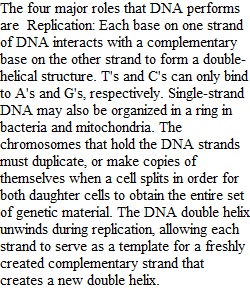


Q Complete the following and submit the Word document by midnight Sunday. Remember to include complete citations for all sources used to answer each question. 1. Explain the four roles that DNA plays in cells? How are these roles influenced by DNA’s structure? Be sure you demonstrate your understanding of DNA’s structure in your answer. 2. Match the terms with the most suitable description. _____ genetic code a. Examples of RNA processing _____ promoter b. Sequence of three nucleotides that code for an amino acid. _____ exon c. Location on DNA where RNA polymerase attaches. _____ intron d. Sequence of three nucleotides that is complementary to a codon triplet. _____ anticodon e. Portion of a gene that is excised from the RNA transcript. _____ codon f. Rules that convert a nucleotide sequence into a protein. _____ cap and tail g. Parts of a gene that are expressed. 3. Briefly explain the differences among messenger RNA, transfer RNA and ribosomal RNA in terms of the roles they play in transcription and translation and where they are found in the cell. 4. Using the genetic code table (Fig 10.11 on p 180), take the following DNA sequence and complete the following: T A C C C C A T G T A A C A T A C C A C T Complementary DNA strand _________________________________ mRNA strand _____________________________________________ Amino acid sequence _____________________________________________________ 5. Part of the coding sequence of a gene produces an mRNA sequence of A U G A A G G C U C C U C C A A G C G G C DNA sequence _________________________________ Amino acid sequence _____________________________________________ 6. Review pp 178-185 in your book and view the following animation. Then complete the following table. You may need to watch it the video more than once to catch the details. Genome British Columbia. 2007. Gene Expression Question Transcription Translation What is it, in brief? [[[[[[ [[[[[[ Where does it occur in the cell? [[[[[[ [[[[[[ What is the product? [[[[[[ [[[[[[ Describe how the product is modified to reach its final form. [[[[[[ [[[[[[ ________________________________________ The following Grading Rubric will be used to score your homework: Questions Expectation Points 1 Identifies DNA’s roles and relates them to its structure. 0-8 2 Demonstrates an understanding of transcription and translation. 0-7 3 Correctly differentiates among the three types of RNA. 0-3 4 Demonstrates an understanding of transcription and translation. 0-5 5 Demonstrates an understanding of transcription and translation. 0-4 6 Demonstrates an understanding of transcription and translation. 0-8 TOTAL {{{{{{{{{{ 35 pts PreviousNext
View Related Questions